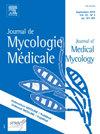Disseminated histoplasmosis in erythematosus systemic lupus: A case report and review
IF 1.8
4区 医学
Q3 MYCOLOGY
引用次数: 0
Abstract
Histoplasmosis is an endemic mycosis in some regions affecting particularly immunosuppressed individuals. The global prevalence of disseminated histoplasmosis in systemic lupus erythematosus (SLE) patients is <1 %, but rises in endemic areas such as Colombia. Clinical manifestations in those patients are atypical, ranging from non-specific symptoms to severe cases of multi-organ failure. Given its rarity and the nonspecific nature of its symptoms, disseminated histoplasmosis in the context of systemic lupus erythematosus remains a diagnostic challenge.
A 28-year-old female patient with a history of SLE diagnosed in 2009 presented to our clinic in February 2024. The patient reported an acute onset of non-specific symptoms, with a subsequent treatment for a suspected bacterial lung infection and successfully discharged. However, due to persistent fever and ongoing weight loss, she returned for further evaluation. Initially a thoracic computed tomography and fiberoptic bronchoscopy was performed, with negative results for tuberculosis (TB), however TB treatment was empirically initiated according to imagenological findings. During hospitalization, the patient developed gastrointestinal bleeding, prompting further investigations and confirming Histoplasma capsulatum in a biopsy. Despite the antifungal therapy, the patient’s condition deteriorated, culminating in multiorgan failure and death 10 days later.
This case underscores the importance of prompt and accurate diagnosis of disseminated histoplasmosis in patients with SLE. The clinical presentation can mimic a lupus flare or other infectious diseases, potentially delaying the initiation of appropriate therapy. In endemic regions such as Latin America, it is critical to include disseminated histoplasmosis in the differential diagnosis of febrile illness in immunosuppressed patients.
系统性红斑狼疮并发弥散性组织胞浆菌病1例报告及复习
组织胞浆菌病是一种地方性真菌病,在某些地区尤其影响免疫抑制的个体。系统性红斑狼疮(SLE)患者中弥散性组织胞浆菌病的全球患病率为1%,但在哥伦比亚等流行地区有所上升。这些患者的临床表现是非典型的,从非特异性症状到严重的多器官功能衰竭。鉴于其罕见性和其症状的非特异性,弥散性组织胞浆菌病在系统性红斑狼疮的背景下仍然是一个诊断挑战。患者为女性,28岁,2009年确诊SLE病史,于2024年2月来我院就诊。患者报告急性发作的非特异性症状,随后因疑似细菌性肺部感染接受治疗,并成功出院。然而,由于持续发烧和持续体重下降,她返回进一步评估。最初进行了胸部计算机断层扫描和纤维支气管镜检查,结果为结核(TB)阴性,但根据影像学结果开始了结核病治疗。住院期间,患者出现胃肠道出血,促使进一步调查并在活检中确认荚膜组织浆体。尽管进行了抗真菌治疗,但患者病情恶化,最终导致多器官衰竭,10天后死亡。本病例强调了及时准确诊断SLE患者播散性组织胞浆菌病的重要性。临床表现可以模仿狼疮发作或其他传染病,潜在地延迟适当治疗的开始。在拉丁美洲等流行地区,将播散性组织浆菌病纳入免疫抑制患者发热性疾病的鉴别诊断是至关重要的。
本文章由计算机程序翻译,如有差异,请以英文原文为准。
求助全文
约1分钟内获得全文
求助全文
来源期刊
CiteScore
5.10
自引率
2.80%
发文量
68
审稿时长
6-12 weeks
期刊介绍:
The Journal de Mycologie Medicale / Journal of Medical Mycology (JMM) publishes in English works dealing with human and animal mycology. The subjects treated are focused in particular on clinical, diagnostic, epidemiological, immunological, medical, pathological, preventive or therapeutic aspects of mycoses. Also covered are basic aspects linked primarily with morphology (electronic and photonic microscopy), physiology, biochemistry, cellular and molecular biology, immunochemistry, genetics, taxonomy or phylogeny of pathogenic or opportunistic fungi and actinomycetes in humans or animals. Studies of natural products showing inhibitory activity against pathogenic fungi cannot be considered without chemical characterization and identification of the compounds responsible for the inhibitory activity.
JMM publishes (guest) editorials, original articles, reviews (and minireviews), case reports, technical notes, letters to the editor and information. Only clinical cases with real originality (new species, new clinical present action, new geographical localization, etc.), and fully documented (identification methods, results, etc.), will be considered.
Under no circumstances does the journal guarantee publication before the editorial board makes its final decision.
The journal is indexed in the main international databases and is accessible worldwide through the ScienceDirect and ClinicalKey platforms.

 求助内容:
求助内容: 应助结果提醒方式:
应助结果提醒方式:


